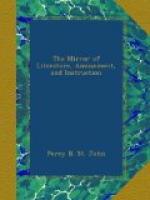* * * * *
SPIRIT OF DISCOVERY
POTTERY.
Appended to the volume of the Transactions of the Society of Arts, just published, are selections from a series of Illustrations on Pottery and Porcelain, which were read before the Society by their ingenious secretary, Mr. Arthur Aikin. We quote a few.
Raphael China.
“Raffaello himself is said in his youth to have painted, or at least to have given designs for painting, in enamel on glazed earthenware. Such works are commonly known by the name of Raphael china, two interesting specimens of which, from the collection of R.H. Solly, Esq., are now before you. From some casual flaws in the back of these plates, it may be seen that the body of them is red earthenware in one, and grayish brown in the other, and of rather a coarse quality. Mr. Windus also has sent a plate, doubtless of Italian manufacture, bearing the date of 1533, thirteen years after the death of Raffaello. He has also sent a singular specimen of a somewhat similar ware, but with the figures in high relief, and far inferior to the former as a work of art.
“Mr. Brockedon informs me that, in his journey among the alps last year, he saw some beautiful specimens of Raphael china, in the possession of the hostess of an inn at the village of Rauris, in Carinthia. They consisted of three dishes; the subjects painted on them are, Pan and Apollo, Jupiter and Semele, and on the largest, Apollo surrounded by wreaths of nymphs and satyrs, and on the rim are entwined Cupids: this latter dish is about twenty inches in diameter, and bears an inscription, in Italian, purporting that it was made at Rome, in 1542, in the manufactory of Guido di Merlingho Vassaro, a native of Urbino. The date is twenty-two years after the death of Raphael; but, as the manufacturer was a fellow-townsman of that celebrated artist, the inscription, taken in connexion with the anecdote of Vasari already mentioned, is interesting, as throwing light on the association of the name of Raffaello with this species of ware.”




